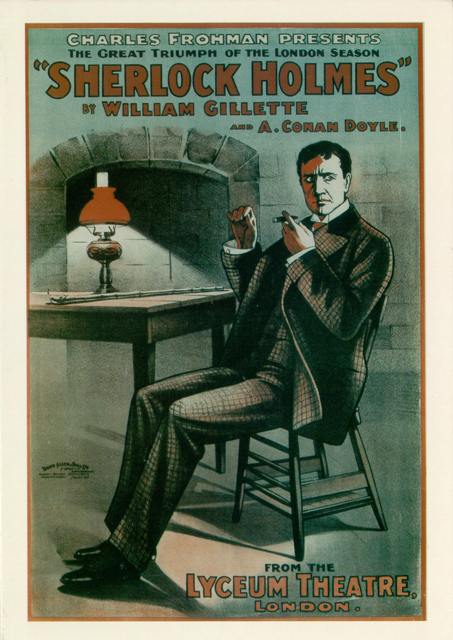Sherlock On Stage.
“You may marry him, murder him, or do anything you like to him.“ Such was Arthur Conan Doyle’s reply to a cable he received one day in 1899. The cable was from the American actor-playwright, William Gillette. Gillette was rewriting a play about Sherlock Holmes. This had originally been penned by Conan Doyle.
The play had been read by the theatrical producer, Charles Frohman. Frohman was interested in Conan Doyle’s script, but he felt that it needed major revisions. Charles Frohman also decided that William Gillette would be ideal in the role of Sherlock Holmes. There was the added advantage that Gillette could rewrite the play too.
William Gillette (1853 - 1937) was an actor, playwright, stage-manager, and theatre director. His plays include two Civil War dramas - Held by the Enemy (1886), and Secret Service (1895). Held by the Enemy is credited with helping to modernise the theatre of that time.
When he first met Arthur Conan Doyle, William Gillette was dressed in a deerstalker cap and a cape in the style of Sherlock Holmes. Having obtained Conan Doyle’s permission to star in and adapt the play, Gillette set to work.
William Gillette drew material and dialogue from the Sherlock Holmes stories A Study in Scarlet, A Scandal in Bohemia, and The Final Problem. This meant that Arthur Conan Doyle was given a co-author credit, though most of the play was written by William Gillette.
Gillette added a considerable amount of new material. Among this was a love interest for Sherlock Holmes! Named Alice Faulkner in the play, she was based on the character of Irene Adler in A Scandal in Bohemia. (Alice Faulkner was portrayed in the play by the actress Katherine Florence.)
Arthur Conan Doyle was uncomfortable with this at first. However, he later changed his views. In a letter to his mother, Conan Doyle wrote that the play, “…promises to be a very big thing. My agent says there are thousands of pounds in it. It will appear in New York with Gillette as Holmes. So we are cheerful.“
Writing to his brother, Innes Doyle, in June 1899, Arthur Conan Doyle was positive that, “Sherlock Holmes’ is going to be grand. I talked it all over with Gillette. Two of his acts are simply grand. It will appear in America in October.“
Sherlock Holmes: The Strange Case of Miss Faulkner was first performed at the Duke of York Theatre in London on 12 June, 1899. The audience consisted of just three people as the performance was for reasons of copyright only.
The play premiered in America on Broadway at the Garrick Theatre in New York City on 6 November, 1899. It was an immediate success. This was followed by a London opening at the Lyceum Theatre in September, 1901. The play ran there for 200 performances.
In 1903, the actor H.A. Saintsbury took over the role of Sherlock Holmes from William Gillette for a tour of Britain.
William Gillette himself played Sherlock Holmes on stage some 1300 times. He also revised the play on a number of occasions.
Gillette also starred in a silent film adaptation of the play in 1916. Long thought to be a lost movie, a copy of it was found in the Cinematheque film archive in 2014. In 1935, an 82 year old William Gillette reprised the role again in a radio adaptation of the play.
The play was revived again in 1973, to much success. It moved to Broadway in November, 1974. A tour of America then followed. Among the actors who played Sherlock Holmes during that period was Leonard Nimoy - better known as Doctor Spock of Star Trek fame!
Both William Gillette and Arthur Conan Doyle benefitted considerably from the success of the play. Gillette had a mansion built for himself in Hadlyme in Connecticut. Gillette Castle was designed to his own specifications, and cost just over one million dollars. The role of Sherlock Holmes had indeed brought William Gillette fame and fortune.
END.

Related
Comments
Comments are disabled for this post.

 to add an item to your Itinerary basket.
to add an item to your Itinerary basket.





